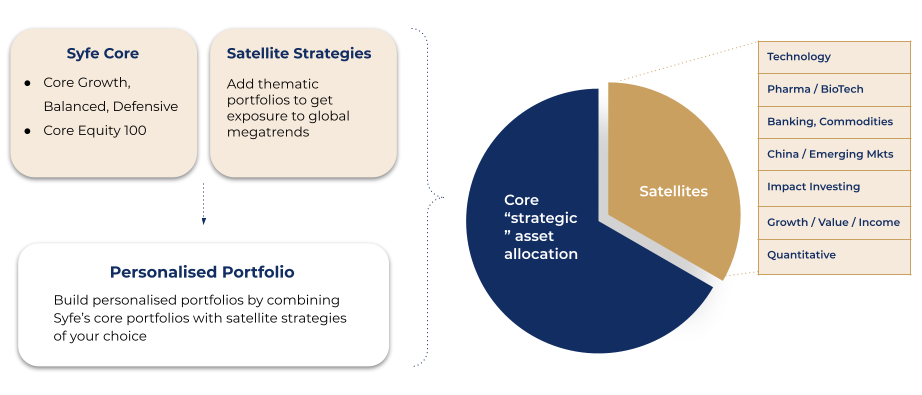If you’ve been attending our webinars or following our blog, you might have realised that we talk about core-satellite investing. A lot.
Why? Because it works. It’s an approach that builds wealth over time by offering the best of both worlds: a core investment tailored to your personal goals, and satellites that let you express your investment ideas.
Here’s what to know.
A planet and its moons
One way to visualize core-satellite investing is to think of a planet (your core) surrounded by its moons (your satellites).

A good core investment should include both stocks and bonds with exposure to different sectors and geographies. Exchange-traded funds (ETFs) are the easiest and most cost-effective way of achieving this. Because a single ETF is usually invested in hundreds, if not thousands, of securities, you get maximum diversification with just one purchase.
With a core set of well-diversified ETFs, you’d be able to keep costs low while capturing market returns as efficiently as possible.
Satellites are investments that help you take advantage of market opportunities and your own investment convictions. They complement your core and offer targeted exposures to certain sectors or themes you’re optimistic about.
For instance, you might want to align your outlook on climate change with environmentally responsible investments.
How should you structure your core-satellite strategy?
As with all asset allocation decisions, you should start by understanding your investment goals, risk appetite, and time horizon. This would help you determine the right mix of asset classes for your portfolio.
For example, if you have a conservative risk tolerance i.e. you’re not prepared to take much investment risk, you could be more suited to portfolios that hold a higher allocation to bonds and a smaller exposure to stocks. That’s because although stocks have the potential for gains, they also come with more volatility, especially in the short term.
The bulk of your portfolio should be held in your core investment. As satellite investments typically carry more risk than your core holdings, you should keep them to about 10% – 30% of your portfolio.

Putting it all together
Implementing a core-satellite strategy can be as simple as owning two portfolios. For your core component, start with a diversified ETF portfolio. You can consider Syfe Core portfolios or pick broad-based index funds.
Your satellite investments can include specific stock picks, thematic ETFs, or real estate, among other assets. For example, you could add an ESG or healthcare thematic portfolio from Syfe Select.
A sample allocation might be 80% in Syfe Core Growth and 20% in the ESG & Clean Energy portfolio from Syfe Select.
Ultimately, core-satellite investing is all about finding the right combination. It balances stability and flexibility by allowing you to benefit from market returns while enjoying the excitement of pursuing investment opportunities outside of your core portfolio.
Interested to see how different Syfe portfolios can be used in various core-satellite approaches? Read our next article in this series on core-satellite investing, or check out our microsite.






You must be logged in to post a comment.